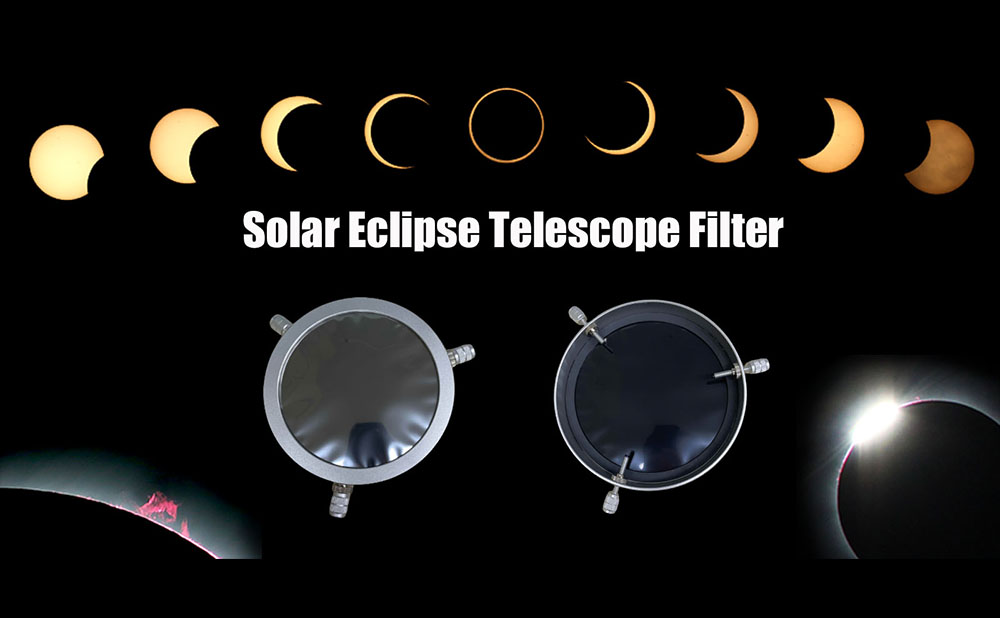Table of Contents

Solar Telescope Filters
Solar Telescope Filters
Solar filters are a great way to view the sun without investing too much in a specialized telescope; all you need to do is find the right solar filter for the telescope you already have, and then continue to view the sun with the telescope you're familiar with.
What are solar filters for telescopes?
Solar filters are attachments placed on telescope lenses for safe viewing of the sun. Designed to block all or most of the sun's rays, they allow you to view or photograph the sun's constant activity or eclipses without harming your eyes. Directly observing the bright surface of the sun can be seriously hazardous to the human eye, but a quality solar filter can provide you with the protection you need to safely observe and capture images of the nearest star.
Types of solar filters
There are two types of solar filters: white light and hydrogen-alpha (or H-alpha). White light filters block 99.99% of the sun's light, thus allowing viewers to see the visible surface of the sun, known as the photosphere. White light filters can be made from polymers (such as Mylar) or glass. White light filters range in price from under $30 for solar filters to $120 or more for quality glass filters designed for large aperture telescopes.
Hydrogen-alpha filters clearly image the sun's chromosphere - the layer directly above the photosphere where most of the sun's activity occurs. Once available only to professional astronomers, H-alpha filters are much more expensive than white light filters, with prices starting at $180 or more. But H-alpha filters can show more detail than white-light filters because they pick up light from hot hydrogen atoms in the Sun's upper layers.
How to use a solar filter?
For maximum safety and optimal viewing, you should always place the solar filter on the front of the telescope and it should fit snugly over the optical tube. Some low-cost telescopes have solar filters on the eyepieces at the viewing end, but this puts a high concentration of sunlight directly in your eyes.
How to choose a solar filter for your telescope?
Look for a quality filter from a well-known brand, and make sure it’s designed to fit your camera. If you’re just starting out in solar observation, white light filters are less expensive than H-alphas. However, they reveal a different view of the sun’s layers. Glass filters are typically safer than film filters since they aren’t prone to pinpricks or tears that can let in direct sunlight.
A solar filter can turn any telescope into a solar telescope. Filters are available for telescopes of all sizes and for other viewing devices such as binoculars and cameras. Correctly placed over the lens, they block the sun’s intense light on certain wavelengths, making it possible to observe solar features such as sunspots and filaments directly, just as you might view a star at night.
What must be emphasized?
1. Make sure that the baader astrosolar™ film you buy is indeed the genuine baader film and not a counterfeit product.
2. When using, you must repeatedly check whether there are any holes in your solar filter. Under the action of strong light, even the light transmitted through the holes is enough to cause damage to human eyes.
3. It’s also possible to make a telescope sun filter at home using Mylar film. But a poorly made or inexpensive solar filter can put your eyesight at risk, since even an accidental pinprick or incorrect measurement can let in sunlight that’s magnified by the power of the telescope. That’s why it’s important to make sure you’re using a well-made filter and that it’s placed correctly on your telescope.
4. Make sure the solar filter is placed before the front lens. When placed behind the lens filter, the solar filter itself will be damaged due to heat accumulation or damage, thereby harming the user or the photographic equipment.
Conclusion
Solar filters, as other filters, are divided into imaging filters and visual filters. Click here for more information!
https://www.svbony.com/solar-eclipse-telescope-filter/#W9183B
https://www.svbony.com/blog/2024-total-solar-eclipse/


There are no customer reviews yet . Leave a Reply !